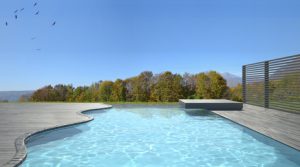How do you create a culture of creativity and problem-solving while addressing all of the  curriculum standards? As you may know about IDE Corp., we love using metaphors and similes to rethink “school” (e.g., “teacher as ferry; teacher as bridge”). So let’s consider the infinity pool: a swimming pool that gives the impression of endlessness and offers exploration while providing supportive boundaries.
curriculum standards? As you may know about IDE Corp., we love using metaphors and similes to rethink “school” (e.g., “teacher as ferry; teacher as bridge”). So let’s consider the infinity pool: a swimming pool that gives the impression of endlessness and offers exploration while providing supportive boundaries.
The Learner-Active, Technology-Infused Classroom is all about Students Taking Charge, that is, having choice and voice within safe boundaries. Let’s break down some of the structures and strategies:
- Teachers consider the curricular standards and design a problem-based task students could accomplish if they mastered those standards. They design a rubric to provide students with clearly articulated expectations. Teachers present the task and rubric to students at the start of the unit, driving the learning! The task and rubric provide a certain set of boundaries, like a pool, to keep students safe within the realm of the curriculum (because, that is what’s expected in schools these days, unless you’re going rogue!).
- An activity list offers a variety of differentiated learning and practice activities to support students in mastering the curricular goals; however, students decide which to use, when to work on them, and with whom they will work. Students have a lot of choice and voice as they “swim” around the learning environment.
- Teachers facilitate learning, helping students make decisions about their learning paths, providing direct instruction, and probing thinking to move students to higher levels of understanding.
- Every Authentic Learning Unit (ALU) that begins with a task and rubric results in students’ demonstration of knowledge through the creation of some sort of product or performance. If the product or performance itself is not a part of the curricular goals, teachers should allow students to present in a variety of ways. For example, if you’re teaching poetry writing, students may be limited to writing a poem; but if you’re asking students to present a solution to designing a zoo habitat for an animal, you can allow them to present that through a written proposal, video, multimedia presentation, scale model, or any other means, because your curriculum is about habitats, not presentations.
The structures of the Learner-Active, Technology-Infused Classroom are what enable the freedom. Within those structures, students are empowered to explore, make decisions, be creative, and invent. Make your classroom a swimming pool, metaphorically speaking, that is. Change the world!
